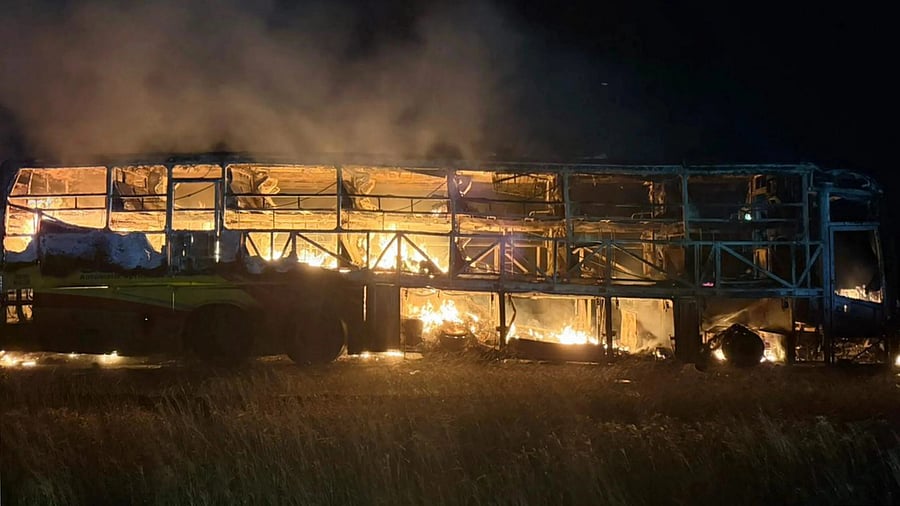
Kurnool bus tragedy.
Credit: PTI Photo
The bus fire tragedy in Kurnool, which claimed the lives of about 20 people on Friday, has put the spotlight onto the safety concerns in sleeper buses. Transport department officials and industry insiders flag issues on location of emergency exits and illegal modification of sleeper coaches.
The private bus, operated by V Kaveri Travels, had about 40 passengers on board when it went up in flames after colliding with a motorcycle coming in the opposite direction. As per preliminary reports, only about half the passengers managed to escape from the bus.
Emergency exits remain a major problem in sleeper buses, said an industry insider. “When there is an emergency and you are in a seater bus, you can move away immediately. That is not the case with sleeper buses. There are many obstacles, including the railings and curtains, which come in the way when trying to approach the emergency exit. The gallery space is also limited. This is especially dangerous when one has just woken up from sleep and is trying to find a way,” he said, adding that private operators are more likely to flout safety regulations, often illegally modifying seater buses into sleeper coaches.
“Early on, buses by Volvo and a few others had an issue with the diesel tank. It used to be fixed near the bottom half, which had caused some accidents in the past. The company has since resolved the issue by moving the fuel tank near the boot. Since then, such incidents have reduced,” he added.
The private bus involved in the accident, a 42-seater Scania bus, was 7 years and 2 months old, and registered under the Rayagada RTO in Odisha, with all valid documentation. However, it had 16 unpaid traffic violations in Hyderabad, for overspeeding, driving on the wrong side, and unauthorised parking, among other things.
“The bus was registered under the All India Tourism Permit (AITP), under which it is allowed to operate for 12 years. This shows that the bus wasn’t a faulty old bus. After the 8-year period, all vehicles are required to renew their fitness certificates annually, rather than every two years. We are very strict about this,” a senior transport department official told DH.
In an attempt to save on taxes, private operators often get their vehicles registered in states charging low taxes, such as Arunachal Pradesh, Dadra and Nagar Haveli and Nagaland, said another transport department official. “We’re trying to curb this by cracking down on AITP buses, which operate solely in and around Karnataka but are registered in different states. If the buses are registered here, we can keep a track on them,” he said.
Negligence evident, high-level probe sought: DKS
Deputy Chief Minister D K Shivakumar said that a high-level investigation into the bus tragedy has been sought. Highlighting that negligence is evident in the case, he added, “An investigation should be conducted to find out the cause of the accident. This is not a minor incident. We should ensure that such a tragedy does not happen again.”
Transport Minister Ramalinga Reddy also reiterated that safety was the top priority of the state government. “Our transport department is very strict when it comes to safety norms. I have always been strict about the need for proper functioning of emergency exits in all buses, ever since the 2013 bus fire tragedy when I was the transport minister,” he said.